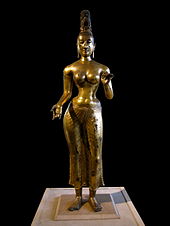Buddhism in Sri Lanka
The Buddhism in Sri Lanka is the most popular in the country religion . About 69.1% of the total population, mainly Sinhalese , belong to Theravada Buddhism.
history
According to one of the traditional Sri Lankan chronicles, the Dipavamsa , the Buddha's teaching came in the 2nd century BC. By the son of the Indian emperor Ashoka , Mahinda , to the island. At that time, King Devanampiya Tissa ruled over large parts of the country (reign: 307–267 BC). He converted to Buddhism and had the Sri Mahi Bodhi planted in Anuradhapura , a descendant of the poplar-fig tree under which Siddhartha Gautama is said to have found enlightenment.
Colonial times
From the 16th century onwards, the Portuguese , Dutch and British colonialists initiated Christian missionaries in the areas they had conquered.
At the end of the 19th century a nationwide Buddhist movement began, which found many followers in the country. One of the main reasons was the Panadura debate between a Christian priest and the Buddhist monk Migettuwatte Gunananda Thera , which the latter won. As a result, more and more sections of the population turned more consciously to Buddhism.
The entire Sinhalese reform Buddhism, however, was largely based on Anagarika Dharmapala, who endeavored to put a stop to the increasing influence of Christian schools and missionaries on the educational class of Ceylon by undertaking a new conception of Buddhism in contrast to Christianity. He established Buddhism as a religion of reason that renounced superstition and also conformed to the findings of science. Classical Buddhism, which as monk Buddhism was only accessible to a certain class, Dharmapala opened up to a middle path so that laypeople could also realize personal salvation.
Current time
In the present day Buddhism in Sri Lanka has partly combined with a Sinhalese nationalism. This is because in Sri Lanka the religious borders are to a large extent also ethnic borders. The Buddhists are predominantly Sinhalese, while the Sri Lankan Tamils are mostly Hindus and, more rarely, Muslims. Historically speaking, some of the Muslims in Sri Lanka are descendants of Arab traders and some of the Christians are descendants of Dutch and Portuguese colonial rulers. When (supposed) Sinhalese interests are at stake, Buddhist monks often also play a prominent role, even in openly violent conflicts e.g. B. with Muslims. Some Sinhala nationalist organizations are led or were founded by Buddhist monks, such as the parties Jathika Hela Urumaya and Bodu Bala Sena .
In these respects Buddhism in Sri Lanka is similar to Buddhism in Myanmar (Burma).
numbers
Development of Buddhism from 1881 to 2001:
| year | Buddhists | |||||||||||
|---|---|---|---|---|---|---|---|---|---|---|---|---|
| number | percent | |||||||||||
| 1881 census | 1,698,100 | 61.53 | ||||||||||
| 1891 census | 1,877,000 | 62.40 | ||||||||||
| 1901 census | 2,141,400 | 60.06 | ||||||||||
| 1911 census | 2,474,200 | 60.25 | ||||||||||
| 1921 census | 2,769,800 | 61.57 | ||||||||||
| 1931 estimate | 3,266,600 | 61.55 | ||||||||||
| 1946 census | 4,294,900 | 64.51 | ||||||||||
| 1953 census | 5,209,400 | 64.33 | ||||||||||
| 1963 census | 7,003,300 | 66.18 | ||||||||||
| 1971 census | 8,536,800 | 67.27 | ||||||||||
| 1981 census | 10,288,300 | 69.30 | ||||||||||
| 2001 1st census | ||||||||||||
| 2011 census | 14,222,844 | 70.20 | ||||||||||
| Source: Department of Census and Statistics | ||||||||||||
1 Not included as the 2001 census was only carried out in 18 of 25 districts.
literature
- Heinz Bechert : Buddhism, State and Society in the Countries of Theravada Buddhism. Volume I: Basics. Ceylon. Göttingen: Seminar for Indology and Buddhist Studies at Univ. Göttingen 1988 (= Hamburg 1966).
- Michael B. Carrithers: “You will be the masters of the island”: Buddhism in Sri Lanka. In: Heinz Bechert, Richard Gombrich (ed.): The Buddhism. Past and present . Munich: CH Beck ³2008. Pp. 140-168.
- Richard Gombrich : Theravada Buddhism: From ancient India to modern Sri Lanka . Stuttgart, Berlin, Cologne: Kohlhammer 1996.
- Swearer, Donald K. (1970): Lay Buddhism and the Buddhist Revival in Ceylon , Journal of the American Academy of Religion 38 (3), 255-275
Web links
- Chronic from Sri Lanka (English)
Individual evidence
- ^ The World Factbook: Sri Lanka . In: CIA World Factbook . Retrieved August 12, 2006.
- ↑ Walter Wijenayake: Ven Migettuwatte Gunananda . In: island.lk . The Island. September 20, 2008. Retrieved April 29, 2009.
- ↑ Anagarika Dharmapala: The World's Dept to Buddha . In: Ananda Guruge (Ed.): Return to Righteousness. A Collection of Speeches, Essays, Letters of the Anagarika Dharmapala. Anagarika Dharmapala Birth Centenary Committee, Colombo 1965, p. 3-22 .
- ↑ Statistical Abstract 2008, Department of Census & Statistics
- ↑ Department of Census and Statistics Sri Lanka: Population by religion according to districts, 2012 .



